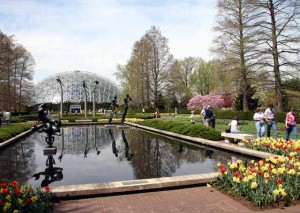 An American Daffodil Society Display Garden is established to display a wide variety of daffodil cultivars to the general public. Its purpose is to educate the visitor about daffodils and how they can be used effectively in the landscape.
An American Daffodil Society Display Garden is established to display a wide variety of daffodil cultivars to the general public. Its purpose is to educate the visitor about daffodils and how they can be used effectively in the landscape.
In an approved ADS Display Garden, visitors may view a large number of many varieties of daffodils that are labeled and grow in a well-maintained garden setting. To obtain official display garden status, certain criteria are to be met.
The American Daffodil Society Display Garden Program criteria are as follows:
- A Display Garden shall be a member in good standing of the ADS. If an organization or individual has been an ADS member for less than two (2) years, the garden must be actively involved with an local/regional daffodil society.
- All daffodils grown in a garden setting shall be clearly marked with the proper registered name, color code and date of introduction/hybridization as applicable. Daffodils grown in drifts do not need to be so marked.
- Display Gardens shall be well-maintained (mulched, fertilized, adequately watered, foliage properly maintained, reasonably free of weeds) to demonstrate how daffodils can be grown in gardens by the visiting public. An “American Daffodil Society Display Garden” sign, provided by the ADS, shall be displayed during the growing season.
- Display Gardens, public and private, shall be made available to the public during the blooming season, with hours posted or appointment information posted on the ADS web site. The American Daffodil Society’s insurance policy does not include Display Garden visitation. Garden owners are encouraged to carry their own insurance.
- For Display Gardens at public venues, the managing organization is requested to provide public acknowledgment of the ADS Display Garden on its own web site and encourage inclusion on garden literature provided to the public. The managing organization is also encouraged to provide information to the public on growing daffodils (which may be obtained from the ADS).
- The Display Garden may set whatever theme it chooses. If the display is “historic” (heirloom), the garden shall follow the ADS and RHS conventions for historic daffodils. Display of traditionally grown lost-name historics and species is acceptable, as long as division and color code are included on markers.
- Display Gardens at large public gardens are strongly encouraged to provide for a display of all Wister and Pannill winners (as suited to the climate), and strive for a collection of no less than 100 varieties. Large collections should include as many divisions as are easily grown for the climate, and ideally provide a balanced display of species, historics and commercially available popular garden and show cultivars.
- Display Gardens shall be visited and reviewed by the ADS Regional Vice Presidents (RVPs) or chosen designee on a bi-annual basis, to provide support and educational information as warranted. Gardens in disrepair or not following proper cultivation methods shall be encouraged to improve. The RVP may request to the ADS Garden Program Chair, gardens with little prospect for improvement be removed from the ADS Display Garden program.
- Registered Display Gardens shall be posted on the ADS web site. Updated contact information, garden description, directions, etc., shall be provided annually by the garden to the RVP and ADS Garden Program Chair.
- An annual renewal application must be returned by September 1 by the registered Display Garden to the ADS Garden Program Chair. Display Garden Renewal Form
Please complete this Display Garden Request form to become an ADS Display Garden today! Display Garden Program Application
For more information about the American Daffodil Society Display Garden please contact American Daffodil Society Display Garden Chair, Tom Stettner 
 Join us in Herndon, Virginia from April 10 – 13, 2024 for the ADS National Convention! Refer to the
Join us in Herndon, Virginia from April 10 – 13, 2024 for the ADS National Convention! Refer to the